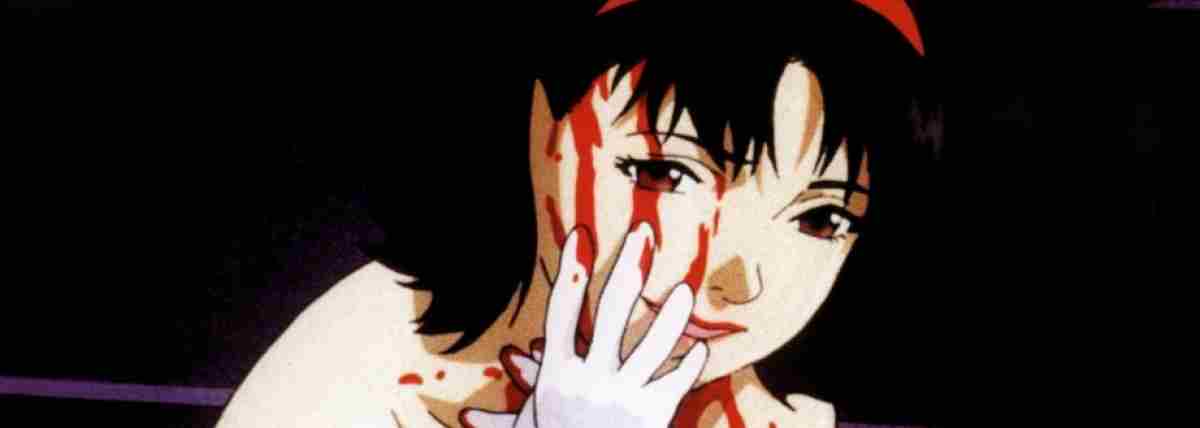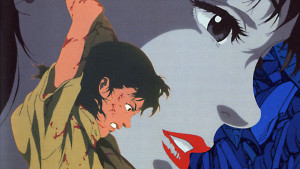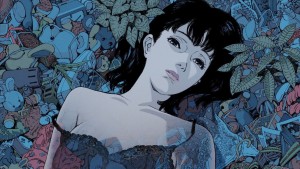Perfect Blue & Horror
June 2, 2015 · 1 comment
By Andrew Osmond.
 Five years ago, I wrote the saddest article of my career, an obituary of the great Japanese director Satoshi Kon. Naturally, I mentioned his slasher-film debut Perfect Blue, and said it was “perhaps the only effective horror film in animation.” It was a generalised, rash claim to make; yet Perfect Blue is still a landmark both of animation and horror.
Five years ago, I wrote the saddest article of my career, an obituary of the great Japanese director Satoshi Kon. Naturally, I mentioned his slasher-film debut Perfect Blue, and said it was “perhaps the only effective horror film in animation.” It was a generalised, rash claim to make; yet Perfect Blue is still a landmark both of animation and horror.
If you haven’t seen Perfect Blue, it could be called a psycho-thriller or a slasher film. But perhaps it’s best just to call it a mindf***, full of non-linear storytelling. The set-up, though, is clear and specific. It’s set in what was the present day when the film was released (1997), and tells the story of a woman, Mima, performing in an ‘idol’ singer group in Tokyo.
As the film opens, she announces she’s leaving the group; her sleazy manager hopes to make her into an actress. Her first role’s in a gruesome crime thriller serial that’s being written on the fly. Suddenly she’s told to act in a scene in which her character is raped. She gets anonymous threats, and starts to have visions of a doppelganger, a ghost Mima mocking her as a ‘filthy adult woman.’ Then people start dying violently, and Mima enters a mental Moebius strip, where reality and delusion fuse into an endless nightmare.
Nearly twenty years after its release, the film plays as a period drama, most obviously in Mima’s comical ignorance of the new-fangled Internet. In many ways, though, Perfect Blue is startlingly up to date, especially in its portrayal of the net as a minefield where people make anonymous threats and steal identities. Mima is flamed for dirtying her public image; it foreshadows the notorious ‘apology’ video by AKB48 singer Minami Minegishi in 2013, after she committed the crime of being seen with a boyfriend. For an eighteen year-old film, Perfect Blue is impressively topical.
 As a horror film – and that’s what it undoubtedly is – it’s been commonly linked to Alfred Hitchcock’s films, especially Vertigo and Psycho, for its visions of mental breakdown and collapsing identity. Perfect Blue’s non-linear, delusional-maze narrative – basically, it’s a film about madness which goes mad – is comparable to Brian De Palma’s Raising Cain (1992). The lurid set-piece murders also led critics to compare Perfect Blue to vintage Dario Argento films like Suspiria (1977), though Kon hadn’t seen them when he made his film.
As a horror film – and that’s what it undoubtedly is – it’s been commonly linked to Alfred Hitchcock’s films, especially Vertigo and Psycho, for its visions of mental breakdown and collapsing identity. Perfect Blue’s non-linear, delusional-maze narrative – basically, it’s a film about madness which goes mad – is comparable to Brian De Palma’s Raising Cain (1992). The lurid set-piece murders also led critics to compare Perfect Blue to vintage Dario Argento films like Suspiria (1977), though Kon hadn’t seen them when he made his film.
Most contentiously, Perfect Blue is frequently linked with Darren Aronofsky’s ballet horror Black Swan (2010), where Natalie Portman plays a pressured dancer beset by delusions and doppelgangers. There’s a basis for the rumour. Aronofsky had bought the rights to Perfect Blue a decade earlier, but ended up merely cloning one scene for his 2000 Requiem for a Dream (here’s a side-by-side comparison). For many fans, it’s an unquestionable ‘fact’ that Black Swan is a rip-off, despite Aronofsky’s specific denials. He said Swan’s real inspiration, not unreasonably, was the original ballet Swan Lake.
My own judgement on Black Swan, in Judge Dredd Megazine, was that the film broke down when Portman’s character did. “It becomes a vulgarised rendition of Polanski’s Repulsion or Perfect Blue… overfamiliar, overwrought and silly, the heated carry-ons redeemed in part by the on-stage climax, which invokes the true magic of ballet.”
But beyond live-action comparisons, what of Perfect Blue’s place as animated horror? A clarification; when I deemed it the “only effective horror film in animation,” I was thinking of animated features, a narrow category. Even so, it’s debatable. Many animated features, even for kids, have fine horror scenes, going back to classic Disney. Look at these moments from Snow White, Pinocchio and especially Fantasia, whose huge snarling demon might have helped inspire certain anime posters. And it wasn’t just Disney introducing tots to out-and-out horror; try these moments from Watership Down or The Adventures of Mark Twain.
 Anime, of course, makes many films for older audiences, and a list of its gross-out moments would fill many pages. There aren’t, though, many anime films that are “horror” first and foremost, and certainly not in the Perfect Blue sense. Akira and the gruesome third Berserk film are violent actioners. Legend of the Overfiend mashes up body-horror with lurid porn. One of the most upsetting, and graphically explicit, anime features is 1983’s Barefoot Gen, but it’s not horror; it’s a period drama about the A-bombing of Hiroshima. A rare out-and-out cartoon horror feature is the French anthology Fear(s) of the Dark (2007), but it’s no rival for Perfect Blue.
Anime, of course, makes many films for older audiences, and a list of its gross-out moments would fill many pages. There aren’t, though, many anime films that are “horror” first and foremost, and certainly not in the Perfect Blue sense. Akira and the gruesome third Berserk film are violent actioners. Legend of the Overfiend mashes up body-horror with lurid porn. One of the most upsetting, and graphically explicit, anime features is 1983’s Barefoot Gen, but it’s not horror; it’s a period drama about the A-bombing of Hiroshima. A rare out-and-out cartoon horror feature is the French anthology Fear(s) of the Dark (2007), but it’s no rival for Perfect Blue.
Perfect Blue itself has ‘tough’ moments of horrific violence. For me, the worst involves a broken window and a sliver of glass; in accord with Hitchcock’s principles, you don’t see it slice flesh, but by heavens you feel it. Nonetheless, Perfect Blue’s gore is always secondary to the film’s pervasive sense of hysteria, of Mima being abjectly lost and threatened in a neon landscape.
You can see a fascinating music video (NSFW) that was made for Madonna’s “Drowned World” tour in 2001. It splices moments from Perfect Blue together with even nastier anime. But all the extra ultraviolence feels monotonous beside Perfect Blur’s vibrant terror.
Moreover, toon violence has lost its edge today. It’s too familiar, too mainstream. Witness the interactive CG gore of today’s gaming; or the bloody antics in Family Guy (maybe NSFW); or a French animated music video with overtones of Overfiend (definitely NSFW). Even the artily nightmarish netherworlds of maverick animation, especially stop-motion, are familiar to us now, a gnarly bit of scenery.
Perfect Blue never retreats into such animated artiness. Nor does it drown itself in gore. Despite dealing with dreams and delusions, the film keeps itself real – and that’s why Perfect Blue is great horror, and a great film.
Andrew Osmond is the author of 100 Animated Feature Films. Perfect Blue is available in the UK from Anime Ltd.
Benjamin Bissett
June 7, 2015 10:44 am
Thanks for writing a brilliant article on PERFECT BLUE, Osmond. I remember first seeing the film when it aired on SyFy Channel in late-2002, when it was called Sci-Fi Channel and it didn't show made-for-TV movie dross like it does nowadays. I thought it was a powerful and brilliant film. In fact, I can say that PERFECT BLUE is my favourite movie of 1997, the year it first debuted. Can't believe it's now nearly five years since Satoshi Kon tragically passed away. He should have lived longer. But his legacy will live on forever, and one of the gems he created was this terrific anime thriller.